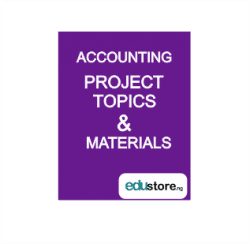CHAPTER ONE
1.1 BACKGROUND OF THE STUDY
According to Reece, (1975), the accounting profession essentially involves the supply of information to decision makers. Hence, it is not surprise that accountants have always been involved in many information related problems. The need for this involvement is underscored by the avowed aim of accounting which according to the American association committee to prepare A statement of basic accounting theory (SOBAT, 1961).
SOBAT, (19610, described Accounting as the provision of relevant economic information to permit informed judgment and decision by users of the information.
The attainment of this objective, necessarily, requires both the identification as well as the disclosure of adequate amount of information considered relevant by the users.
Financial accounting covers those activities related to the preparation of certain reports which are known as financial statements. These statements report the financial status of the firm at a particular time the firms activities and resulting profits and losses during the most recent period, and the flow of resources occurring within the firm during the same period.
Information, according to Reece, (1975) is a fact, datum, observation, perception or any other thing that adds to knowledge.
According to Joan, (1978), information is the information is the life wire of any organization. He further said that the success of any organization whether profit or non-profit oriented depends particularly on how the information needs of the different levels of management are met.
Information can either be quantitative or non quantitative and out of many quantitative information, accounting is one. It is distinguished from other types of information because it is usually expressed in monetary terms, though non-monetary information are also often contained in accounting reports in order to enhance the understanding of the manager.
Joan, (1978) affirmed that accounting information serves various uses; these users have different decisions to make and consequently, their information often differ.
In order that accounting information may be most useful, it is adapted to the particular needs of users.
-Shareholders and investors whose main concern is with the value of the capital investment and expected dividend.
-Management whose planning, controlling and decision making functions would be highly ineffective without quality information. Financial reports are also an indication of management efficiency.
-Creditors and potential creditors such as bankers bondholders, suppliers of goods and services they deduce from accounting information, the profitability and financial soundness of the business to enable them decide whether to expand or decrease financial commitment in the business.
-Government, in order to calculate the company’s tax liabilities, regulates rules and evolve policies through the use of accounting information.
Employees who seek assurance of steady employer to ensure how frequently they would participate in company’s bonus, profit sharing and pension plans.
May, 1980, described that decision making is the process of choosing from among alternative courses of actions, conclusion and so forth, according to some criterion or criteria adopted by decision-making is the prime job of managers. And for as long as men have been striving together to accomplish tasks of making decisions about scare resources in uncertain situations, management has been practiced, and information has been necked.
DOWNLOAD COMPLETE WORK- For Reference Only: Materials are for research, citation, and idea generation purposes and not for submission as your original final year project work.
- Avoid Plagiarism: Do not copy or submit this content as your own project. Doing so may result in academic consequences.
- Use as a Framework: This complete project research material should guide the development of your own final year project work.
- Academic Access: This platform is designed to reduce the stress of visiting school libraries by providing easy access to research materials.
- Institutional Support: Tertiary institutions encourage the review of previous academic works such as journals and theses.
- Open Education: The site is maintained through paid subscriptions to continue offering open access educational resources.






